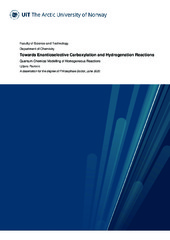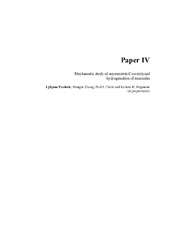| dc.contributor.advisor | Hopmann, Kathrin Helen | |
| dc.contributor.author | Pavlovic, Ljiljana | |
| dc.date.accessioned | 2020-08-11T10:51:48Z | |
| dc.date.available | 2020-08-11T10:51:48Z | |
| dc.date.issued | 2020-08-21 | |
| dc.description.abstract | With the aid of DFT methods, it is possible to get insights into the mechanistic details of homogeneous reactions, the substrate preferences and activities of catalysts. Computational methods can also help to identify the selectivity-determining factors that govern asymmetric reactions. In this thesis, DFT methods are applied in order to study the enantioselective addition of small molecules, such as CO2 and H2, to alkenes in order to form saturated carboxylic acids and alkanes.
Both rhodium-mediated hydrocarboxylation and cobalt-mediated hydrogenation reactions were investigated using the popular DFT functionals PBE and B3LYP, including dispersion corrections. First, the nonselective Rh-cyclooctadiene(COD)-catalyzed hydrocarboxylation of alkenes with CO2 was studied by employing the PBE-D2 functional. Several styrene derivatives and α,β-unsaturated compounds were analyzed. Our computational investigation of Rh-COD-benzyl complexes revealed an unusual TS for the C-CO2 bond formation step, where CO2 does not interact with the metal center and the substrate is coordinated to the metal in a η6-fashion via a phenyl ring. The study was expanded by analyzing the potential of five chiral ligands, (S)-SEGPHOS, (R,R)-BDPP, (R,R)-tBu-BOX, (S)-iPr-PHOX, and (R)-StackPhos, to form Rh-based catalysts for asymmetric hydrocarboxylations. Interestingly, the preferred carboxylation TSs with chiral Rh-complexes display a similar substrate binding mode as with the achiral COD ligand and also show a preference for outer sphere CO2 insertion. However, the results indicate that different CO2 insertion paths, frontside or backside, are possible, dependent on the nature of the ligand. For ligands containing an N-heterocyclic ring, it is shown that CO2 is able to form stacking interactions with the ring, which for several ligands results in a preference for frontside CO2 insertion.
Second, a detailed mechanistic investigation of Co-catalyzed asymmetric hydrogenation of enamides was performed at the B3LYP-D3 level of theory. The study of enamides with very different molecular structures shows that two mechanistic pathways appear accessible, both a non-redox Co(II) mechanism proceeding through metallacycle intermediates and a more classical redox Co(0)/Co(II) mechanism. The obtained barriers indicate that these mechanisms may be competing. It is also shown that explicit solvent affects the computed barriers significantly and that its inclusion appears to be crucial for the proper estimation of the enantiomeric excesses of Co-catalyzed hydrogenation of enamides. | en_US |
| dc.description.doctoraltype | ph.d. | en_US |
| dc.description.popularabstract | Metals can be used as catalysts to mediate the formation of chemical compounds. Insights into such reactions can be obtained with computational methods. In my PhD work, I used quantum chemistry to study the metal-catalyzed formation of chemicals that are important for the pharmaceutical industry.
Part of my work focused on using the metal rhodium to activate CO2 towards making new bonds. This work is important because CO2 is a promising carbon source that can replace fossil carbon in the chemical industry. My results show that CO2 is activated without binding to rhodium. This insight can help in the design of CO2 reactions that are selective for a certain product.
Rhodium is expensive and chemists are trying to replace it with the cheaper metal cobalt. Part of my work focused on cobalt-catalyzed hydrogenation reactions. My results show that cobalt catalysts can access many different reaction pathways. Knowledge about these pathways can help in the design of better cobalt catalysts. | en_US |
| dc.description.sponsorship | The Department of Chemistry at UiT, Tromsø Research Foundation, Research Council of Norway, NordForsk and Notur. | en_US |
| dc.identifier.isbn | 978-82-8236-400-3 (trykt), 978-82-8236-401-0 (pdf) | |
| dc.identifier.uri | https://hdl.handle.net/10037/18943 | |
| dc.language.iso | eng | en_US |
| dc.publisher | UiT Norges arktiske universitet | en_US |
| dc.publisher | UiT The Arctic University of Norway | en_US |
| dc.relation.haspart | <p>Paper I: Pavlovic, L., Vaitla, J., Bayer, A. & Hopmann, K.H. (2018). Rhodium-Catalyzed Hydrocarboxylation: Mechanistic Analysis Reveals Unusual Transition State for Carbon–Carbon Bond Formation. <i>Organometallics, 37</i>, 941–948. Not available in Munin due to publisher’s restrictions. Published version available at <a href=https://doi.org/10.1021/acs.organomet.7b00899>https://doi.org/10.1021/acs.organomet.7b00899</a>. Accepted manuscript version available in Munin at <a href=https://hdl.handle.net/10037/14465>https://hdl.handle.net/10037/14465</a>.
<p>Paper II: García-López, D., Pavlovic, L. & Hopmann, K.H. (2020). To bind or not to bind: Mechanistic insights into C–CO<sub>2</sub> bond formation with late transition metals. <i>Organometallics, 39</i>(8), 1339-1347. Also available in Munin at <a href= https://hdl.handle.net/10037/18129>https://hdl.handle.net/10037/18129</a>.
<p>Paper III: Pavlovic, L., Pettersen, M., Gevorgyan, A., Vaitla, J., Bayer, A. & Hopmann, K.H. Computational and experimental insights into asymmetric Rh-catalyzed hydrocarboxylation with CO<sub>2</sub>. (Manuscript). Now published in the <i>European Journal of Organic Chemistry, 2021</i>, <a href=https://doi.org/10.1002/ejoc.202001469>https://doi.org/10.1002/ejoc.202001469</a>.
<p>Paper IV: Pavlovic, L., Zhong, H., Chirik, P.J. & Hopmann, K.H. Mechanistic study of asymmetric Co-catalyzed hydrogenation of enamides. (Manuscript). | en_US |
| dc.rights.accessRights | openAccess | en_US |
| dc.rights.holder | Copyright 2020 The Author(s) | |
| dc.rights.uri | https://creativecommons.org/licenses/by-nc-sa/4.0 | en_US |
| dc.rights | Attribution-NonCommercial-ShareAlike 4.0 International (CC BY-NC-SA 4.0) | en_US |
| dc.subject | VDP::Mathematics and natural science: 400::Chemistry: 440::Theoretical chemistry, quantum chemistry: 444 | en_US |
| dc.subject | VDP::Matematikk og Naturvitenskap: 400::Kjemi: 440::Teoretisk kjemi, kvantekjemi: 444 | en_US |
| dc.subject | Carboxylation | en_US |
| dc.subject | Hydrogenation | en_US |
| dc.subject | Modelling of Homogeneous Reactions | en_US |
| dc.subject | Enantioselective Reactions | en_US |
| dc.title | Towards Enantioselective Carboxylation and Hydrogenation Reactions (Quantum Chemical Modelling of Homogeneous Reactions) | en_US |
| dc.type | Doctoral thesis | en_US |
| dc.type | Doktorgradsavhandling | en_US |


 English
English norsk
norsk


